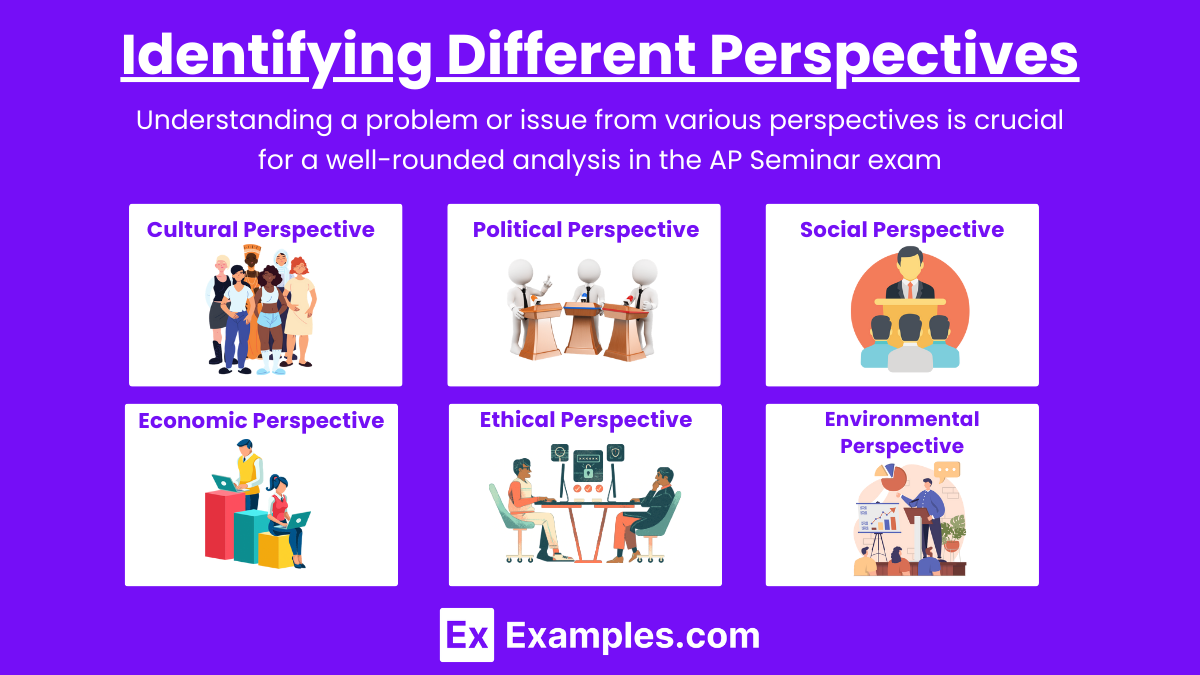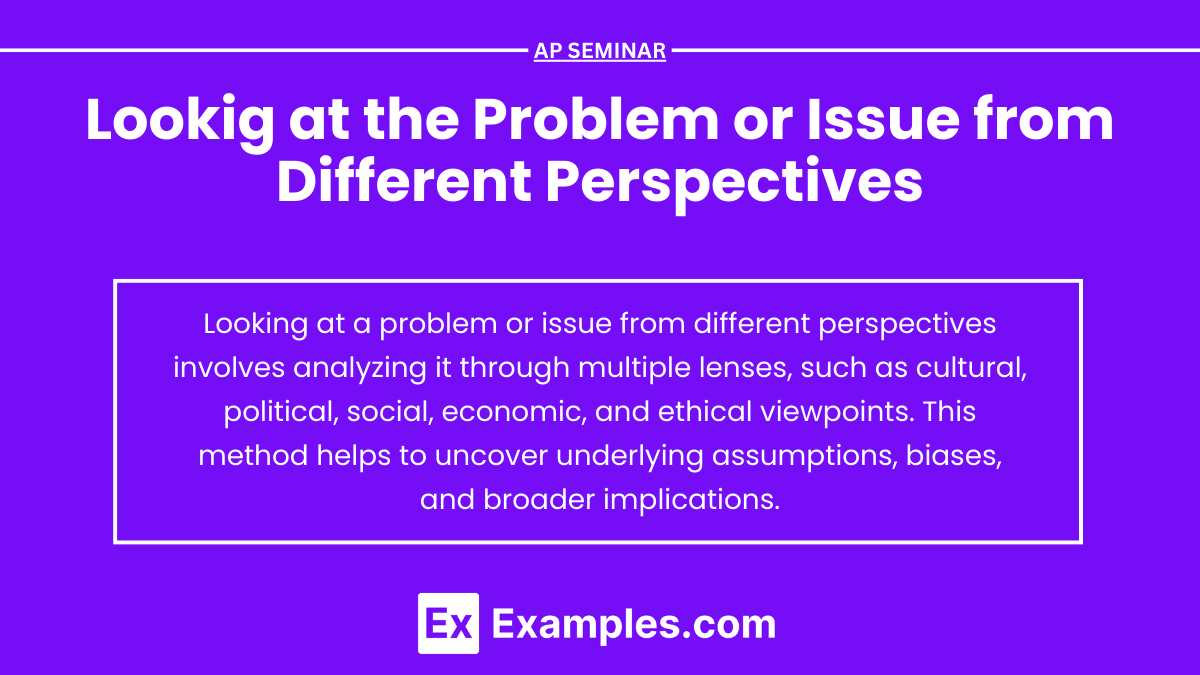Looking at a problem or issue from different perspectives involves analyzing it through multiple lenses, such as cultural, political, social, economic, and ethical viewpoints. This method helps to uncover underlying assumptions, biases, and broader implications. By considering diverse perspectives, you can develop a more balanced and insightful argument, which is essential for success in the AP Seminar exam.
Learning Objectives
Looking at the Problem or Issue from Different Perspectives for the AP Seminar exam, you should learn to identify and understand various viewpoints, such as cultural, political, social, economic, ethical, and environmental perspectives. This includes analyzing the strengths and weaknesses of each perspective, recognizing biases, and synthesizing different viewpoints to develop a comprehensive and balanced argument. Mastering these skills will enhance your critical thinking, improve your argumentative writing, and prepare you to address complex issues with a nuanced and well-rounded approach.
Identifying Different Perspectives

Understanding a problem or issue from various perspectives is crucial for a well-rounded analysis in the AP Seminar exam. Here's a look at different perspectives to consider.
Cultural Perspective
Values and Beliefs: Different cultures have unique values and belief systems that shape their understanding and approach to issues. For example, views on family roles, education, and healthcare can vary significantly across cultures.
Traditions and Practices: Cultural traditions and practices influence behaviors and responses to problems. For instance, traditional medicine practices may differ from modern medical approaches.
Example: In healthcare, Western medicine emphasizes scientific evidence, while Eastern medicine may focus on holistic approaches.
Political Perspective
Government Policies: Political perspectives analyze how government policies and regulations impact issues. This includes legislation, political agendas, and public policies.
Power Dynamics: Examines how power relations and political ideologies influence decision-making processes and outcomes.
Example: Climate change policies: Different countries have varied approaches to environmental regulations, reflecting their political priorities and economic interests.
Social Perspective
Social Norms: Social norms dictate acceptable behaviors and attitudes within a society. These norms can influence public opinion and social behavior.
Group Identity: Considers the perspectives of different social groups, including race, gender, class, and ethnicity.
Example: Gender roles: Social perspectives on gender can affect issues like workplace equality and educational opportunities.
Economic Perspective
Economic Impact: Evaluates the financial implications and economic factors related to the issue. This includes costs, benefits, and economic sustainability.
Resource Allocation: Focuses on how resources are distributed and the economic inequalities that may arise.
Example: Unemployment: Economic perspectives analyze the causes and consequences of unemployment, including policy responses and labor market trends.
Ethical Perspective
Moral Values: Ethical perspectives consider moral values and principles, such as justice, fairness, and responsibility.
Rights and Justice: Focuses on issues of human rights, equality, and legal justice.
Example: Medical ethics: Issues like euthanasia, stem cell research, and patient confidentiality are examined through ethical lenses.
Environmental Perspective
Ecological Impact: Evaluates the effects of human activities on the environment, including biodiversity, climate change, and pollution.
Conservation and Resources: Focuses on sustainable practices and the management of natural resources.
Example: Deforestation: Environmental perspectives analyze the impact of deforestation on ecosystems, climate, and indigenous communities.
Analyzing Perspectives

Analyzing perspectives involves examining different viewpoints and understanding how they shape the argument. This skill is crucial for critically engaging with texts and constructing well-rounded arguments.
Strengths and Weaknesses
Evaluate Evidence: Assess the evidence supporting each perspective.
Consider Biases: Identify potential biases and limitations in each viewpoint.
Relevance: Determine the relevance of each perspective to your research question.
Comparative Analysis
Contrast and Compare: Highlight similarities and differences between perspectives.
Interconnections: Explore how different perspectives interrelate and influence each other.
Synthesizing Perspectives
Integrating Viewpoints
Balanced Synthesis: Combine insights from various perspectives to form a cohesive argument.
Highlighting Key Points: Emphasize the most significant findings from each perspective.
Developing Arguments
Comprehensive Argumentation: Build arguments that reflect a well-rounded understanding.
Addressing Counterarguments: Acknowledge and refute counterarguments to strengthen your position.
Importance of Examining Multiple Perspectives
Examining multiple perspectives is essential for developing a comprehensive understanding and constructing well-rounded arguments. Here are the key points listed:
1. Comprehensive Understanding
Depth of Analysis: Provides a deeper and multifaceted understanding of an issue.
Broader Context: Places the issue in a broader context, revealing root causes and interconnected factors.
2. Critical Thinking
Challenge Assumptions: Encourages questioning and challenging underlying assumptions.
Identify Bias: Helps recognize and address biases in sources and arguments.
3. Balanced Argumentation
Strengthened Arguments: Creates robust and convincing arguments by integrating diverse insights.
Acknowledging Counterarguments: Enhances credibility by addressing and refuting counterarguments.
4. Innovation and Problem Solving
Creative Solutions: Leads to innovative and effective solutions by combining different approaches.
Collaborative Thinking: Fosters a culture of collaboration and inclusivity.
5. Ethical and Social Awareness
Enhanced Ethical Understanding: Provides a deeper understanding of the ethical implications of decisions.
Social Responsibility: Promotes empathy and drives socially responsible actions and policies.
6. Academic and Professional Growth
Skill Development: Enhances critical thinking, analytical skills, and intellectual flexibility.
Preparation for Real-World Issues: Prepares for addressing complex real-world challenges requiring multidisciplinary approaches.


